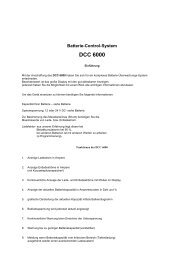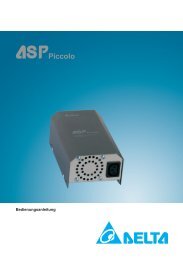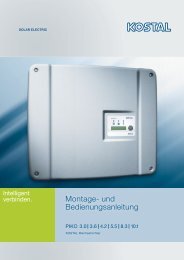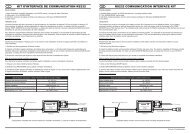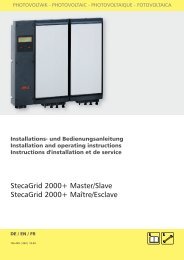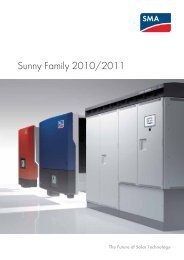MBR 12/24-100, MBR 12/24-160 AND MBR 12/24-500
MBR 12/24-100, MBR 12/24-160 AND MBR 12/24-500
MBR 12/24-100, MBR 12/24-160 AND MBR 12/24-500
You also want an ePaper? Increase the reach of your titles
YUMPU automatically turns print PDFs into web optimized ePapers that Google loves.
Description<br />
BATTERY SEPARATOR<br />
<strong>MBR</strong> <strong>12</strong>/<strong>24</strong>-<strong>100</strong>, <strong>MBR</strong> <strong>12</strong>/<strong>24</strong>-<strong>160</strong> <strong>AND</strong><br />
The battery separators (<strong>MBR</strong>) are powerful<br />
mechanical contactors microprocessor<br />
controlled. A <strong>MBR</strong> can be used in a system<br />
consisting of 2 batteries (a start and an<br />
auxiliary battery), like for instance in<br />
boats or in camping-cars.<br />
Possibilities<br />
Connection according to the start<br />
battery voltage<br />
(See Connection p. 2)<br />
In some <strong>12</strong>/<strong>24</strong> V installations (like in a<br />
vehicle), it is preferable that the auxiliary<br />
battery or the appliances are powered<br />
only if the start battery voltage is<br />
sufficient. By connecting a <strong>MBR</strong> between<br />
the start battery and the auxiliary battery<br />
or the appliances, the latter will be then<br />
powered only once the start battery<br />
voltage has reached 13.2/26.4 V during<br />
60 seconds.<br />
Connection of a charger to the<br />
auxiliary battery<br />
(See Connection p. 2)<br />
This is usual, in a boat or in a camping-car<br />
to connect a battery charger to the<br />
<strong>MBR</strong> <strong>12</strong>/<strong>24</strong>-<strong>500</strong><br />
auxiliary battery. In using a <strong>MBR</strong>, the start<br />
battery will also be charged if the voltage<br />
of the second battery is higher than<br />
13.2/26.4 V during 5 seconds. In case<br />
your boat/vehicle would stay without<br />
running for a long time, your start battery<br />
will then still remain <strong>100</strong>% charged. From<br />
the stop of the charger, the contactor will<br />
open as soon as it detects a voltage<br />
threshold below <strong>12</strong>.8/25.6 V during 60<br />
seconds.<br />
Contact for start assistance<br />
(See Connection p. 2)<br />
By connecting the terminal STATUS to the<br />
positive (+) pole of the auxiliary battery<br />
via the start contactor, the <strong>MBR</strong> will<br />
commute the second battery at the start<br />
of your boat/camping-car.<br />
Security in case of overvoltage<br />
(See Connection p. 2)<br />
In case for instance of a fault of the<br />
alternator voltage regulator, the system<br />
voltage can easily overcome the voltage<br />
limits allowed for the auxiliary battery<br />
and/or the appliances. This is why, in case<br />
of an overvoltage, the <strong>MBR</strong> will detect the<br />
fault and will disconnect the auxiliary<br />
battery and/or the appliances in order to<br />
protect them.<br />
517/<strong>MBR</strong> User manual (En–Fr–De–Sp) 1 / 8 V2.1.0
STUDER Innotec <strong>MBR</strong> – User Manual<br />
Connection for the <strong>MBR</strong> <strong>12</strong>/<strong>24</strong>-<strong>100</strong><br />
and -<strong>160</strong><br />
30 Positive pole (+) of the start battery<br />
85 Ingnition contact (only if « start<br />
assistance » is wished)<br />
86 Negative pole (-) of the system<br />
Cautious: this connection must<br />
always be protected with a fuse of<br />
3A !<br />
87 Connected to the positive pole (+) of the<br />
auxiliary battery (state of the variable<br />
relay as per the voltage)<br />
Connection for the <strong>MBR</strong> <strong>12</strong>/<strong>24</strong>-<strong>500</strong><br />
A1 Positive pole (+) of the start battery.<br />
A2 Positive pole (+) of the auxiliary<br />
battery or of the appliances.<br />
STAT. 3 modes<br />
1 Connected to the positive pole (+),<br />
relay closed.<br />
2 No voltage, state of the variable<br />
relay as per the voltage.<br />
3 Connected to the negative pole (-),<br />
relay closed.<br />
LED Not used.<br />
MIN. Negative pole (-) of the system.<br />
Caution, this pole must always be<br />
connected !<br />
Warning ! The start and auxiliary batteries must always have the same nominal voltage !<br />
Technical specifications<br />
<strong>MBR</strong> <strong>12</strong>/<strong>24</strong>-<strong>100</strong> and (-<strong>160</strong>) <strong>MBR</strong> <strong>12</strong>/<strong>24</strong>-<strong>500</strong><br />
Voltage Automatical detection Automatical detection<br />
Batteries connection M6 M8<br />
Other connections Male poles 6,3 mm Male poles 6,3 mm<br />
Recommended cable Min. 25 mm² Min. 50 mm²<br />
Nominal current <strong>100</strong> A / (<strong>160</strong> A) <strong>500</strong> A<br />
Peak current 480 A / 250 ms 2000 A / 250 ms<br />
Start voltage 13,2 V@<strong>12</strong> V / 26,4@<strong>24</strong> V 13,2 V@<strong>12</strong> V / 26,4@<strong>24</strong> V<br />
Connection delays 5 s 5 s<br />
Disconnection delays 60 s 60 s<br />
Fast disconnection 11,8 / 23.6 V 11,8 / 23.6 V<br />
Fast disconnection delays 4 s 4 s<br />
Stop in case of overvoltage 16 V@<strong>12</strong> V / 32 V@<strong>24</strong> V 16 V@<strong>12</strong> V / 32 V@<strong>24</strong> V<br />
IP code IP54 IP54<br />
Consumption relay open 1,5 mA@<strong>12</strong> V / 1.5 mA@ <strong>24</strong> V 1,8 mA@<strong>12</strong> V / 2 mA@ <strong>24</strong> V<br />
Consumption relay closed 360 mA@<strong>12</strong> V / <strong>160</strong> mA@<strong>24</strong> V <strong>160</strong> mA@<strong>12</strong> V / <strong>100</strong> mA@<strong>24</strong> V<br />
Start consumption (<strong>100</strong> ms) 3 A@ <strong>12</strong> V / 1,5 A@<strong>24</strong> V 3 A@ <strong>12</strong> V / 1,5 A@<strong>24</strong> V<br />
Weight 286 g 417 g<br />
Dimensions (L x w x h) [mm] 93 x 46 x 77 80 x 70 x 72<br />
517/<strong>MBR</strong> User manual (En–Fr–De–Sp) 2 / 8 V2.1.0
Description<br />
SEPARATEUR DE BATTERIES<br />
<strong>MBR</strong> <strong>12</strong>/<strong>24</strong>-<strong>100</strong>, <strong>MBR</strong> <strong>12</strong>/<strong>24</strong>-<strong>160</strong> ET<br />
Les séparateurs de batteries (<strong>MBR</strong>) sont<br />
des contacteurs mécaniques de forte<br />
puissance pilotés par microprocesseur. Un<br />
<strong>MBR</strong> peut être utilisé lorsqu'un système<br />
est composé de 2 batteries (une batterie<br />
de démarrage et une batterie auxiliaire)<br />
ou d’une batterie de démarrage et des<br />
appareils alimentés en courant continu<br />
(lampe <strong>12</strong>Vdc, etc...) comme par exemple<br />
sur des bateaux ou des camping-cars.<br />
Possibilités<br />
Connexion en fonction de la tension<br />
de batterie de démarrage<br />
(Voir Raccordement p. 2)<br />
Pour certaines installations <strong>12</strong>/<strong>24</strong> V, il est<br />
souhaitable que la batterie auxiliaire ou les<br />
appareils soient uniquement alimentés si le<br />
niveau de la tension de batterie de démarrage<br />
est suffisant. En connectant un <strong>MBR</strong> entre la<br />
batterie de démarrage et la batterie auxiliaire<br />
ou les appareils, ceux-ci seront donc alimentés<br />
lorsque la tension de la batterie de démarrage<br />
aura atteint 13.2/26.4 V durant 60 secondes.<br />
<strong>MBR</strong> <strong>12</strong>/<strong>24</strong>-<strong>500</strong><br />
Raccordement d’un chargeur sur la<br />
batterie auxiliaire<br />
(Voir Raccordement p. 2)<br />
Il est courant, sur un bateau ou dans un<br />
camping-car, de raccorder un chargeur de<br />
batterie sur la batterie auxiliaire. En<br />
utilisant un <strong>MBR</strong>, la batterie de démarrage<br />
sera également chargée si la tension de la<br />
deuxième batterie est supérieure à<br />
13.2/26.4 V durant 5 secondes. Dans le<br />
cas d’un arrêt prolongé de votre<br />
bateau/véhicule, votre batterie de<br />
démarrage restera donc chargée à <strong>100</strong>%.<br />
Dès l’arrêt du chargeur, le contacteur<br />
s'ouvrira aussitôt après avoir détecté un<br />
niveau de tension inférieur à <strong>12</strong>.8/25.6 V<br />
durant 60 secondes.<br />
Contact d’aide au démarrage<br />
(Voir Raccordement p. 2)<br />
En connectant la borne STATUS à la borne<br />
positive (+) de la batterie auxiliaire via le<br />
contacteur de démarrage, le <strong>MBR</strong><br />
commutera la deuxième batterie lors du<br />
démarrage de votre bateau/camping-car.<br />
Sécurité en cas de surtension<br />
(Voir Raccordement p. 2)<br />
Dans le cas par exemple d’un défaut du<br />
régulateur de tension de l'alternateur, la<br />
tension du système peut facilement<br />
dépasser les limites de tensions autorisées<br />
pour la batterie auxiliaire et/ou les<br />
appareils. C’est pourquoi, en cas de<br />
surtension, le <strong>MBR</strong> détectera le défaut et<br />
déconnectera les appareils et/ou la<br />
batterie auxiliaire afin de les protéger.<br />
517/MBC User manual (En–Fr–De–Sp) 3 / 8 V2.1.0
STUDER Innotec <strong>MBR</strong> – Manuel utilisateur<br />
Raccordement pour le<br />
<strong>MBR</strong> <strong>12</strong>/<strong>24</strong>-<strong>100</strong> ET -<strong>160</strong><br />
30 Borne positive (+) de la batterie de<br />
démarrage<br />
85 Contact d’allumage (seulement si "l’aide<br />
au démarrage" est souhaitée)<br />
86 Borne négative (-) du système.<br />
Attention : cette connexion doit<br />
toujours être protégée avec un<br />
fusible de 3A !<br />
87 Relié à la borne positive (+) de la batterie<br />
auxiliaire (état du relais variable en<br />
fonction de la tension)<br />
Raccordement pour le<br />
<strong>MBR</strong> <strong>12</strong>/<strong>24</strong>-<strong>500</strong><br />
A1 Borne positive (+) de la batterie de<br />
démarrage.<br />
A2 Borne positive (+) de la batterie<br />
auxiliaire ou des appareils.<br />
STAT. 3 modes<br />
1 Relié à la borne positive (+), relais<br />
fermé.<br />
2 Aucune tension, état du relais<br />
variable en fonction de la tension.<br />
3 Relié à la borne négative (-), relais<br />
fermé.<br />
LED Non utilisé.<br />
MIN. Borne négative (-) du système.<br />
Attention, cette borne doit toujours<br />
être raccordée !<br />
Avertissement ! La batterie de démarrage et la batterie auxiliaire doivent toujours être de tension<br />
nominale identique !<br />
Spécifications techniques<br />
<strong>MBR</strong> <strong>12</strong>/<strong>24</strong>-<strong>100</strong> et (-<strong>160</strong>) <strong>MBR</strong> <strong>12</strong>/<strong>24</strong>-<strong>500</strong><br />
Tension d'alimentation Détection auto. de la tension Détection auto. de la tension<br />
Raccords batteries M6 M8<br />
Autres raccordements Bornes Faston 6,3 mm Bornes Faston 6,3 mm<br />
Câble conseillé Min. 25 mm² Min. 50 mm²<br />
Courant nominal <strong>100</strong> A / (<strong>160</strong> A) <strong>500</strong> A<br />
Courant crête 480 A / 250 ms 2000 A / 250 ms<br />
Tension de démarrage 13,2 V@<strong>12</strong> V / 26,4@<strong>24</strong> V 13,2 V@<strong>12</strong> V / 26,4@<strong>24</strong> V<br />
Délais à la connexion 5 s 5 s<br />
Délais à la déconnexion 60 s 60 s<br />
Déconnexion rapide 11,8 / 23,6 V 11,8 / 23,6 V<br />
Délais de déconnexion rapide 4 s 4 s<br />
Arrêt en cas de surtension 16 V @ <strong>12</strong> V / 32 V@<strong>24</strong> V 16 V@<strong>12</strong> V / 32 V@<strong>24</strong> V<br />
Code IP IP 54 IP 54<br />
Consommation relais ouvert 1,5 mA@<strong>12</strong> V / 1.5 mA@ <strong>24</strong> V 1,8 mA@<strong>12</strong> V / 2 mA@ <strong>24</strong> V<br />
Consommation relais fermé 360 mA@<strong>12</strong> V / <strong>160</strong> mA@<strong>24</strong> V <strong>160</strong> mA@<strong>12</strong> V / <strong>100</strong> mA@<strong>24</strong> V<br />
Consommation de démarrage (<strong>100</strong> ms) 3 A@ <strong>12</strong> V / 1,5 A@<strong>24</strong> V 3 A@ <strong>12</strong> V / 1,5 A@<strong>24</strong> V<br />
Poids 286 g 417 g<br />
Dimensions (L x l x h) [mm] 93 x 46 x 77 80 x 70 x 72<br />
517/MBC User manual (En–Fr–De–Sp) 4 / 8 V2.1.0
Beschreibung<br />
BATTERIERELAIS<br />
<strong>MBR</strong> <strong>12</strong>/<strong>24</strong>-<strong>100</strong>, <strong>MBR</strong> <strong>12</strong>/<strong>24</strong>-<strong>160</strong> UND<br />
Die Batterierelais (<strong>MBR</strong>) sind<br />
Leistungsstarke mechanische Kontakte<br />
angesteuert von einem Mikroprozessor.<br />
Ein <strong>MBR</strong> kann verwendet werden wenn<br />
eine System aus zwei Batterien besteht<br />
(Starter- und Hilfsbatterie), oder einer<br />
Starterbatterie und Gleichstromverbrauchern<br />
(<strong>12</strong>V Lampe, usw…), wie zum<br />
Beispiel auf Booten oder Camping-Cars.<br />
Anwendungen<br />
Anschluss abhängig von der<br />
Starterbatteriespannung<br />
(Siehe Anschlussplan S. 2)<br />
Für gewisse <strong>12</strong>/<strong>24</strong>V Installationen (in<br />
Fahrzeugen zum Beispiel), ist es<br />
wünschenswert dass die Hilfsbatterie und<br />
die daran angeschlossenen Verbraucher<br />
nur versorgt werden, wenn das<br />
Spannungsniveau der Starterbatterie<br />
hoch genug ist. Durch den Anschluss<br />
eines <strong>MBR</strong> zwischen der Starter- und der<br />
Hilfsbatterie, wir diese daher nur versorgt<br />
wenn die Starterbatteriespannung<br />
während mindestens 60 Sekunden bei<br />
13.2V/26.4V liegt.<br />
<strong>MBR</strong> <strong>12</strong>/<strong>24</strong>-<strong>500</strong><br />
Anschluss eines Ladegerätes auf der<br />
Hilfsbatterie<br />
(Siehe Anschlussplan S. 2)<br />
Es ist üblich, dass auf einem Fahrzeug ein<br />
Batterieladegerät an die Hilfsbatterie<br />
angeschlossen wird. Bei der Anwendung<br />
eines <strong>MBR</strong> wird die Starterbatterie<br />
ebenfalls geladen, wenn die Spannung der<br />
Hilfsbatterie während mind. 5 Sekunden<br />
13.2/26.4V übersteigt. In Fall eines<br />
längeren Stopps Ihres Fahrzeuges/Bootes<br />
wird Ihre Starterbatterie somit immer zu<br />
<strong>100</strong>% geladen sein. Bei einem Halt des<br />
Batterieladegeräts wird sich der Kontakt<br />
öffnen sobald die Spannung während<br />
mind. 60 Sekunden, unter <strong>12</strong>.8/25.6V<br />
liegt.<br />
Startassistent<br />
(Siehe Anschlussplan S. 2)<br />
Beim Anschluss des Plus-Pols der<br />
Hilfsbatterie, über den Anlasser an den<br />
STATUS Kontakt, schaltet der <strong>MBR</strong> die<br />
beiden Batterien zusammen wenn das<br />
Fahrzeug gestartet wird.<br />
Sicherheit im Fall einer Überspannung<br />
(Siehe Anschlussplan S. 2)<br />
Der <strong>MBR</strong> hat ausserdem einen<br />
Überspannungsschutz, welcher die<br />
Batterien und die zusätzlichen<br />
Verbraucher vor einer Überspannung<br />
schützt; hervorgerufen z.B. durch eine<br />
defekte Lichtmaschine. Sobald eine<br />
Spannung höher als 16V (32V) anliegt,<br />
wird der <strong>MBR</strong> den Kontakt umgehend<br />
öffnen.<br />
517/MBC User manual (En–Fr–De–Sp) 5 / 8 V2.1.0
STUDER Innotec <strong>MBR</strong> – Benutzerhandbuch<br />
Anschlussplan für den<br />
<strong>MBR</strong> <strong>12</strong>/<strong>24</strong>-<strong>100</strong> und -<strong>160</strong><br />
30 Plus-Pol (+) der Starterbatterie<br />
85 Start Kontakt (nur wenn « Startassistent<br />
verwendet wird)<br />
86 Minus-Pol (-) des Systems.<br />
Vorsicht, diese Verbindung muss<br />
immer mit einer 3A Sicherung<br />
abgesichert sein !<br />
87 Verbunden mit dem Plus-Pol (+) der<br />
Hilfsbatterie (Zustand des Relais hängt<br />
von der Spannung ab)<br />
Anschlussplan für den<br />
<strong>MBR</strong> <strong>12</strong>/<strong>24</strong>-<strong>500</strong><br />
A1 Plus-Pol (+) der Starterbatterie.<br />
A2 Plus-Pol (+) der Hilfsbatterie oder der<br />
Verbraucher.<br />
STAT. 3 Varianten<br />
1 Angeschlossen am Plus-Pol (+),<br />
Relais geschlossen.<br />
2 Keine Spannung, Zustand des Relais<br />
hängt von der Spannung ab.<br />
3 Verbunden mit dem Minus-Pol (-),<br />
Relais geschlossen.<br />
LED Nicht verwendet.<br />
MIN. Minus-Pol (-) des Systems.<br />
Vorsicht diese Verbindung muss<br />
immer angeschlossen sein !<br />
Warnung ! Die Starterbatterie und die Hilfsbatterie müssen immer die gleiche Nominalspannung<br />
haben!<br />
Technische Angaben<br />
<strong>MBR</strong> <strong>12</strong>/<strong>24</strong>-<strong>100</strong> und (-<strong>160</strong>) <strong>MBR</strong> <strong>12</strong>/<strong>24</strong>-<strong>500</strong><br />
Versorgungsspannung Auto. Erkennung der Spannung Auto. Erkennung der Spannung<br />
Batterieanschluss M6 M8<br />
Weitere Anschlüsse Anschluss männlich 6,3 mm Anschluss männlich 6,3 mm<br />
Empfohlenen Kabel Min. 25 mm² Min. 50 mm²<br />
Nominal Strom <strong>100</strong> A / (<strong>160</strong> A) <strong>500</strong> A<br />
Spitzenstrom 480 A / 250 ms 2000 A / 250 ms<br />
Anlaufspannung 13,2 V@<strong>12</strong> V / 26,4@<strong>24</strong> V 13,2 V@<strong>12</strong> V / 26,4@<strong>24</strong> V<br />
Verzögerung zuschalten 5 s 5 s<br />
Verzögerung wegschalten 60 s 60 s<br />
Schnell-Öffner 11,8 / 23.6 V 11,8 / 23.6 V<br />
Verzögerung Schnell-Öffner 4 s 4 s<br />
Stopp bei Überspannung 16 V@<strong>12</strong> V / 32 V@<strong>24</strong> V 16 V@<strong>12</strong> V / 32 V@<strong>24</strong> V<br />
Schutzart IP54 IP54<br />
Eigenverbrauch Relais offen 1,5 mA@<strong>12</strong> V / 1.5 mA@ <strong>24</strong> V 1,8 mA@<strong>12</strong> V / 2 mA@ <strong>24</strong> V<br />
Eigenverbrauch Relais zu 360 mA@<strong>12</strong> V / <strong>160</strong> mA@<strong>24</strong> V <strong>160</strong> mA@<strong>12</strong> V / <strong>100</strong> mA@<strong>24</strong> V<br />
Anlaufstrom (<strong>100</strong> ms) 3 A@ <strong>12</strong> V / 1,5 A@<strong>24</strong> V 3 A@ <strong>12</strong> V / 1,5 A@<strong>24</strong> V<br />
Gewicht 286 g 417 g<br />
Masse (L x B x H) [mm] 93 x 46 x 77 80 x 70 x 72<br />
517/MBC User manual (En–Fr–De–Sp) 6 / 8 V2.1.0
Descripción<br />
SEPARADOR DE BATERÍAS<br />
<strong>MBR</strong> <strong>12</strong>/<strong>24</strong>-<strong>100</strong>, <strong>MBR</strong> <strong>12</strong>/<strong>24</strong>-<strong>160</strong> Y<br />
Los separadores de batería (<strong>MBR</strong>) son<br />
contactos mecánicos de fuerte potencia<br />
controlados por microprocesador. Un <strong>MBR</strong><br />
puede utilizarse cuando un sistema se<br />
compone de 2 baterías (una batería de<br />
arranque y una batería auxiliar) o de una<br />
batería de arranque y accesorios en<br />
corriente continua (lámparas <strong>12</strong>Vdc, etc.),<br />
como por ejemplo en los barcos o<br />
caravanas.<br />
Posibilidades<br />
Conexión en función de la tensión de<br />
batería de arranque<br />
(Ver conexión p.2)<br />
Para ciertas instalaciones <strong>12</strong>/<strong>24</strong> V (en un<br />
vehículo por ejemplo), es deseable que la<br />
batería auxiliar o los aparatos se<br />
alimenten solamente si la tensión de la<br />
batería de arranque es suficiente.<br />
Conectando un <strong>MBR</strong> entre la batería de<br />
arranque y la batería auxiliar, estos se<br />
alimentarán sólo si la tensión de la batería<br />
de arranque llega a 13.2/26.4 V durante<br />
60 segundos.<br />
<strong>MBR</strong> <strong>12</strong>/<strong>24</strong>-<strong>500</strong><br />
Conexión de un cargador sobre la<br />
batería auxiliar<br />
(Ver conexión p. 2)<br />
A menudo, en un barco o en una<br />
caravana, se conecta un cargador de<br />
batería sobre la batería auxiliar. Utilizando<br />
un <strong>MBR</strong>, la batería de arranque se cargará<br />
también si la tensión de la segunda<br />
batería es superior a 13.2/26.4 V durante<br />
5 segundos. En caso de una parada<br />
prolongada de su barco/vehículo, su<br />
batería de arranque quedará cargada al<br />
<strong>100</strong>%. Desde la parada del cargador, el<br />
contacto se abrirá en cuanto haya<br />
detectado un nivel de tensión inferior a<br />
<strong>12</strong>.8/25.6 V durante 60 segundos.<br />
Contacto de ayuda al arranque<br />
(Ver conexión p. 2)<br />
Conectando el borne STATUS al borne<br />
positivo (+) de la batería auxiliar vía el<br />
contacto de arranque, el <strong>MBR</strong> conmutará<br />
la segunda batería en el momento del<br />
arranque de su barco/caravana.<br />
Seguridad en caso de sobretensión<br />
(Ver conexión p. 2)<br />
En el caso por ejemplo de un defecto del<br />
regulador de tensión del alternador, la<br />
tensión del sistema puede fácilmente<br />
sobrepasar los límites de tensión<br />
autorizados para la batería auxiliar y/o los<br />
aparatos. Por este motivo, en caso de<br />
sobretensión, el <strong>MBR</strong> detectará el defecto<br />
y desconectará los aparatos y/o la batería<br />
auxiliar para protegerlos.<br />
517/MBC User manual (En–Fr–De–Sp) 7 / 8 V2.1.0
STUDER Innotec <strong>MBR</strong> – Manual para utilizador<br />
Conexión para el<br />
<strong>MBR</strong> <strong>12</strong>/<strong>24</strong>-<strong>100</strong> ET -<strong>160</strong><br />
30 Borne positivo (+) de la batería de<br />
arranque<br />
85 Contacto de arranque (solo si se desea la<br />
“ayuda al arranque”)<br />
86 Borne negativo (-) del sistema.<br />
¡ Cuidado, esta conexión debe estar<br />
siempre conectada a través de un<br />
fusible de 3A !<br />
87 Conectado al borne positivo (+) de la<br />
batería auxiliar (estado del relé variable<br />
en función de la tensión)<br />
Conexión para el<br />
<strong>MBR</strong> <strong>12</strong>/<strong>24</strong>-<strong>500</strong><br />
A1 Borne positivo (+) de la batería de<br />
arranque<br />
A2 Borne positivo (+) de la batería auxiliar<br />
o de los aparatos<br />
STAT. 3 modos<br />
1 Conectado al borne positivo (+),<br />
relé cerrado.<br />
2 ninguna tensión, estado del relé<br />
variable en función de la tensión.<br />
3 Conectado al borne negativo (-),<br />
relé cerrado.<br />
LED No utilizado.<br />
MIN. Borne negativo (-) del sistema.<br />
¡Atención, este borne siempre debe<br />
estar conectado!<br />
¡Cuidado! ¡La batería de arranque y la batería auxiliar siempre deben ser de igual tensión nominal!<br />
Especificaciones técnicas<br />
<strong>MBR</strong> <strong>12</strong>/<strong>24</strong>-<strong>100</strong> et (-<strong>160</strong>) <strong>MBR</strong> <strong>12</strong>/<strong>24</strong>-<strong>500</strong><br />
Tensión de alimentación Detección auto. de la tensión Detección auto. de la tensión<br />
Conexión baterías M6 M8<br />
Otras conexiones Bornes macho 6,3 mm Bornes macho 6,3 mm<br />
Cable aconsejado Min. 25 mm² Min. 50 mm²<br />
Corriente nominal <strong>100</strong> A / (<strong>160</strong> A) <strong>500</strong> A<br />
Corriente máxima 480 A / 250 ms 2000 A / 250 ms<br />
Tensión de arranque 13,2 V@<strong>12</strong> V / 26,4@<strong>24</strong> V 13,2 V@<strong>12</strong> V / 26,4@<strong>24</strong> V<br />
Plazo a la conexión 5 s 5 s<br />
Plazo a la desconexión 60 s 60 s<br />
Desconexión rápida 11,8 / 23.6 V 11,8 / 23.6 V<br />
Plazo para desconexión rápida 4 s 4 s<br />
Parada en caso de sobretensión 16 V@<strong>12</strong> V / 32 V@<strong>24</strong> V 16 V@<strong>12</strong> V / 32 V@<strong>24</strong> V<br />
Índice de protección IP54 IP54<br />
Consumo relé abierto 1,5 mA@<strong>12</strong> V / 1.5 mA@ <strong>24</strong> V 1,8 mA@<strong>12</strong> V / 2 mA@ <strong>24</strong> V<br />
Consumo relé cerrado 360 mA@<strong>12</strong> V / <strong>160</strong> mA@<strong>24</strong> V <strong>160</strong> mA@<strong>12</strong> V / <strong>100</strong> mA@<strong>24</strong> V<br />
Consumo de arranque (<strong>100</strong> ms) 3 A@ <strong>12</strong> V / 1,5 A@<strong>24</strong> V 3 A@ <strong>12</strong> V / 1,5 A@<strong>24</strong> V<br />
Peso 286 g 417 g<br />
Dimensiones (l x a x A) [mm] 93 x 46 x 77 80 x 70 x 72<br />
517/MBC User manual (En–Fr–De–Sp) 8 / 8 V2.1.0



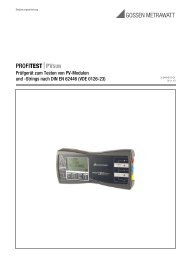
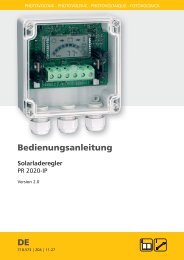
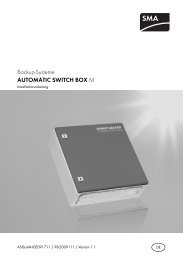

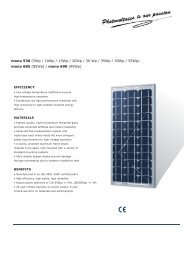
![SCHOTT PROTECT POLY 175-185 data sheet_D[...] - bk solar](https://img.yumpu.com/1309848/1/186x260/schott-protect-poly-175-185-data-sheet-d-bk-solar.jpg?quality=85)
